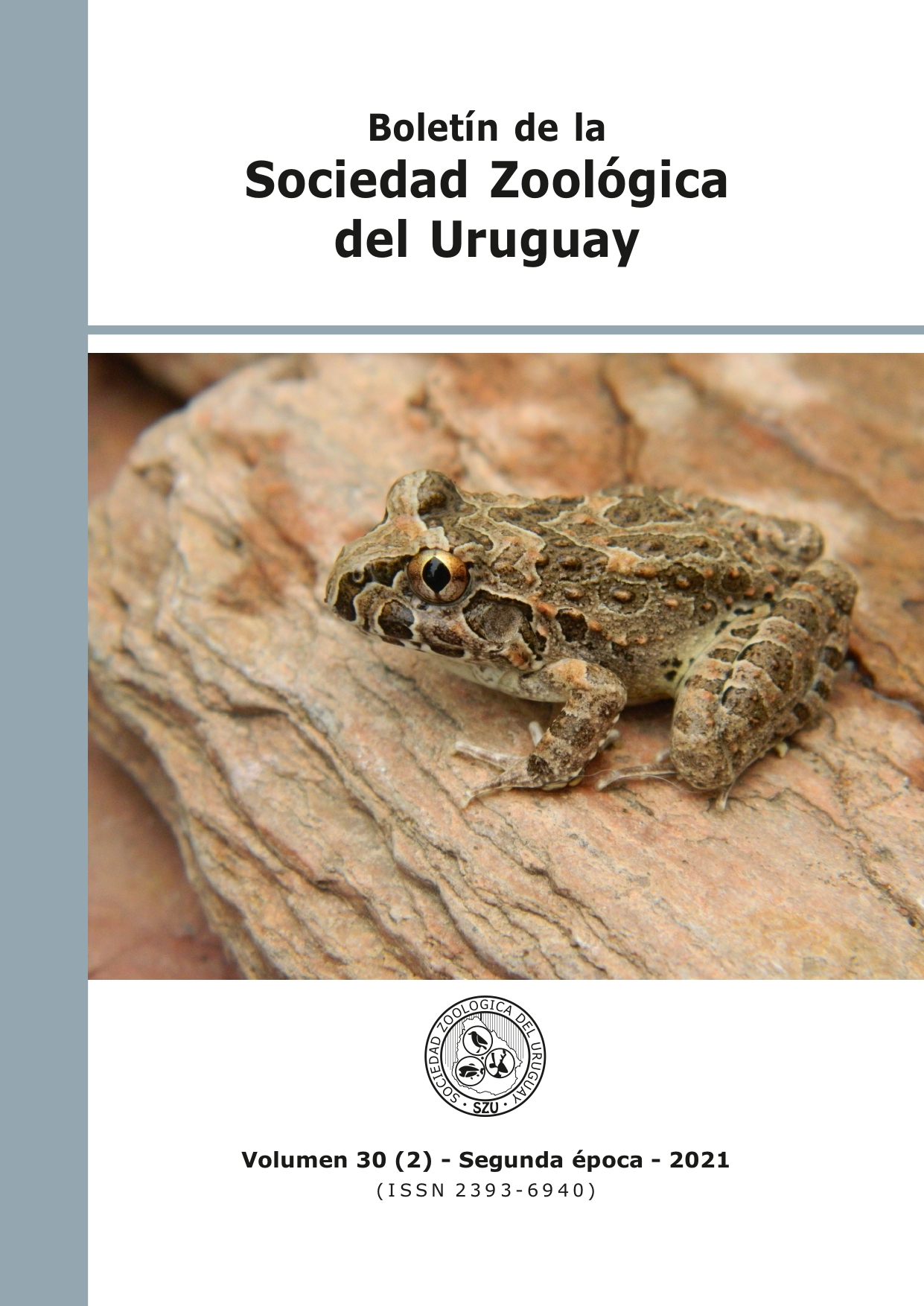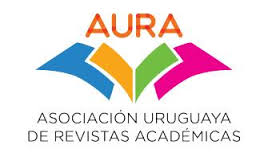LA DIVERSIDAD ESCONDIDA: INVERTEBRADOS DE CHARCOS TEMPORALES EN BARRA GRANDE URUGUAY
DOI:
https://doi.org/10.26462/30.2.5Palabras clave:
Bañados de Rocha , metacomunidades , dominancia , servicios ecosistémicosResumen
Los charcos temporales de Uruguay y los invertebrados que en estos habitan representan ecosistemas relativamente poco explorados, sin referencias claras en relación a los niveles de diversidad que presentan. En el presente trabajo reportamos la presencia de 216 especies y morfoespecies de invertebrados y una estimación total de riqueza entre 263 y 373 morfoespecies, para 18 charcos temporales de la cuenca de la Laguna Castillos, en el departamento de Rocha, Uruguay. Esta diversidad permitiría mantener la estabilidad del funcionamiento del ecosistema y los servicios que este brinda como ser agua potable, forraje para el ganado, limitación en la abundancia de patógenos y brotes de enfermedades o resistencia del sistema frente a contaminantes. Los estudios ecológicos en charcos temporales constituyen excelentes modelos para estudios de biodiversidad ya que proveen resultados generalizables a otros ecosistemas. Sin embargo, una de las limitaciones que encontramos en este trabajo fue la dificultad para la identificación taxonómica de los invertebrados. La gestión y manejo de la diversidad necesita una base taxonómica sólida que permita conocer la composición y estructura de dicha diversidad. Por lo tanto, resaltamos la importancia de realizar estudios en sistemática de invertebrados de agua dulce en Uruguay.
Descargas
Citas
Araujo, J.C., Santos, B., Peçanha, R., y Machado da Silva, A.V. (2013). Haementeria lutzi Pinto, 1920
(Hirudinea: Glossiphoniidae) as a putative Vector of Trypanosoma evansi (Kinetoplastida: Trypanosomatidae) in the Pantanal Matogrossense (MS, Brazil). Entomology, Ornithology & Herpetology, 2(2), 108.
Arim, M., Abades, S.R., Laufer, G., Loureiro, M., y Marquet, P.A. (2010). Food web structure and body size: trophic position and resource acquisition. Oikos, 119(1), 147–153.
Arim, M., Berazategui, M., Barreneche, J.M., Ziegler, L., Zarucki, M., y Abades, S.R. (2011). Determinants of density–body size scaling within food webs and tools for their detection. Advances in Ecological Research, 45, 1–39.
Balian, E.V., Segers, H., Lévèque, C. y Martens, K. (2008). The Freshwater Animal Diversity Assessment: an overview of the results. Hydrobiologia, 595, 627–637.
Bao, L., Martínez, S., Cadenazzi, M., Urrutia, M., Seijas, L., y Castiglioni, E. (2021). Aquatic macroinvertebrates in Uruguayan rice agroecosystem. Biodiversity Data Journal, 9.
Bentancourt Pérez, C.M., Morelli Mazzeo, E.R., y Scatoni, I.B. (2009). Insectos del Uruguay, 595(899), 589–623.
Boix, D., J. Sala, S. Gascón, A. Ruhí, y X. Quintana. (2009). Structure of invertebrate assemblages: contribution to the ecological functioning of the Mediterranean temporary ponds. International conference on mediterranean temporary ponds: proceedings and Abstracts Maó,151–187.
Bonada, N., Prat, N., Resh, V.H., y Statzner, B. (2006). Developments in aquatic insect biomonitoring: a comparative analysis of recent approaches. Annual Review of Entomology, 51, 495–523.
Borthagaray, A.I., Clemente, J.M., Boccardi, L., Brugnoli, E., y Muniz, P. (2006). Impacto potencial de invasión de Ficopomatus enigmaticus (Fauvel) (Polychaeta: Serpulidae) en la Laguna de Rocha, Uruguay. Pan-American Journal of Aquatic Sciences, 1(1), 57–65.
Borthagaray, A.I., Berazategui, M., y Arim, M. (2015a). Disentangling the effects of local and regional processes on biodiversity patterns through taxon‐contingent metacommunity network analysis. Oikos, 124(10), 1383–1390.
Borthagaray, A.I., Pinelli, V., Berazategui, M., Rodríguez-Tricot, L., y Arim, M. (2015b). Effects of metacommunity networks on local community structures: from theoretical predictions to empirical evaluations. En: A.Belgrano, G. Woodward y U. Jacob (Eds.). Aquatic functional biodiversity (pp. 75–111). Academic Press.
Brugnoli, E., Clemente, J., Boccardi, L., Borthagaray, A., y Scarabino, F. (2005). Golden mussel Limnoperna fortunei (Bivalvia: Mytilidae) distribution in the main hydrographical basins of Uruguay: update and predictions. Anais da Academia Brasileira de Ciências, 77(2), 235–244.
Burwood, M., Clemente, J., Meerhoff, M., Iglesias, C., Goyenola, G., Fosalba, C., … Teixeira de Mello, F. (2021). Macroinvertebrate communities and macrophyte decomposition could be affected by land use intensification in subtropical lowlandstreams. Limnetica, 40(2), 343–357.
Canavero, A., Hernández, D., Zarucki, M., y Arim, M. (2014). Patterns of co‐occurrences in a killifish metacommunity are more related with body size than with species identity. Austral Ecology, 39(4), 455–461.
Chang, F.H., Lawrence, J.E., Rios-Touma, B., y Resh, V.H. (2014). Tolerance values of benthic macroinvertebrates for stream biomonitoring: assessment of assumptions underlying scoring systems worldwide. Environmental monitoring and assessment, 186(4), 2135–2149.
Chao, A. (1987). Estimating the population size for capture-recapture data with unequal catchability. Biometrics, 783–791.
Chao, A., y Chiu, C.H. (2016). Nonparametric estimation and comparison of species richness. eLS, 1–11.
Chapin Iii, F.S., Zavaleta, E.S., Eviner, V.T., Naylor, R.L., Vitousek, P.M., Reynolds, H.L., ... Díaz, S. (2000). Consequences of changing biodiversity. Nature, 405(6783), 234–242.
Chester, E.T., y Robson, B.J. (2013). Anthropogenic refuges for freshwater biodiversity: their ecological characteristics and management. Biological Conservation, 166, 64–75.
Clemente, J.M., Boll, T., Teixeira-de Mello, F., Iglesias, C., Roer, A., Pedersen, E.J., y Meerhoff, M. (2019). Role of plant architecture on littoral macroinvertebrates in temperate and subtropical shallow lakes: a comparative manipulative field experiment. Limnetica, 38(2), 759–772.
Clemente, J.M., y Brugnoli, E. (2002). First record of Limnoperna fortunei (Dunker, 1857) (Bivalvia: Mytilldae) in continental waters of Uruguay (Rio Negro and Rio Yi). Boletín de la Sociedad Zoológica del Uruguay, 13, 29–33.
Collier, K.J., Probert, P.K., y Jeffries, M. (2016). Conservation of aquatic invertebrates: concerns, challenges and conundrums. Aquatic Conservation: Marine and Freshwater Ecosystems, 26(5), 817–837.
Collinson, N.H., Biggs, J., Corfield, A.H. M.J., Hodson, M.J., Walker, D., Whitfield, M., y Williams, P.J. (1995). Temporary and permanent ponds: an assessment of the effects of drying out on the conservation value of aquatic macroinvertebrate communities. Biological conservation, 74(2), 125–133.
Cunillera‐Montcusí, D., Borthagaray, A.I., Boix, D., Gascón, S., Sala, J., Tornero, I., … Arim, M. (2021). Metacommunity resilience against simulated gradients of wildfire: disturbance intensity and species dispersal ability determine landscape recover capacity. Ecography, 44(7).
Cunillera‐Montcusí, D., Arim, M., Gascón, S., Tornero, I., Sala, J., Boix, D., y Borthagaray, A.I. (2020). Addressing trait selection patterns in temporary ponds in response to wildfire disturbance and seasonal succession. Journal of Animal Ecology, 89(9), 2134–2144.
De Meester, L., Declerck, S., Stoks, R., Louette, G., Van De Meutter, F., De Bie, T., ... & Brendonck, L. (2005). Ponds and pools as model systems in conservation biology, ecology and evolutionary biology. Aquatic conservation: Marine and freshwater ecosystems, 15(6), 715-725.
Davies, B., Biggs, J., Williams, P., Whitfield, M., Nicolet, P., Sear, D., … Maund, S. (2008). Comparative biodiversity of aquatic habitats in the European agricultural landscape. Agriculture, Ecosystems & Environment, 125(1-4), 1–8.
Domínguez, E., y Fernández, H.R. (2009). Macroinvertebrados bentónicos sudamericanos. Sistemática y biología. Fundación Miguel Lillo, Tucumán, Argentina, 656.
Epele, L.B., y Miserendino, M.L. (2016). Temporal dynamics of invertebrate and aquatic plant communities at three intermittent ponds in livestock grazed Patagonian wetlands. Journal of Natural History, 50(11-12), 711–730.
EPCN (2008). The Pond Manifesto; European Pond Conservation Network. https://freshwaterhabitats.org.uk/wp-contentuploads/2016/06/EPCN-MANIFESTO.pdf [Consulta: 10 de junio de 2021].
Fargione, J.E., y Tilman, D. (2005). Diversity decreases invasion via both sampling and complementarity effects. Ecology Letters, 8(6), 604–611.
Gaston, K.J. (1991). The magnitude of global insect species richness. Conservation biology, 5(3), 283–296.
Garay‐Narváez, L., Arim, M., Flores, J.D., y Ramos‐Jiliberto, R. (2013). The more polluted the environment, the more important biodiversity is for food web stability. Oikos, 122(8), 1247–1253.
Gimenez, L., Borthagaray, A.I., Rodríguez, M., Brazeiro, A., y Dimitriadis, C. (2005). Scaledependent patterns of macrofaunal distribution in soft-sediment intertidal habitats along a largescale estuarine gradient. Helgoland Marine Research, 59(3), 224–236.
Graça, M.A. (2001). The role of invertebrates on leaf litter decomposition in streams–a review. International Review of Hydrobiology: A Journal Covering all Aspects of Limnology and Marine Biology, 86(4-5), 383–393.
Giangrande, A. (2003). Biodiversity, conservation, and the 'Taxonomic impediment'. Aquatic Conservation: Marine and Freshwater Ecosystems, 13(5), 451–459.
Gotelli, N.J., y Colwell, R.K. (2011). Estimating species richness. Biological diversity: frontiers in measurement and assessment, 12(39–54), 35.
Haddad, N.M., Brudvig, L.A., Clobert, J., Davies, K.F., Gonzalez, A., Holt, R.D., … Townshend, J.R. (2015). Habitat fragmentation and its lasting impact on Earth's ecosystems. Science advances, 1(2), e1500052.
Heckman, C.W. (2006). Encyclopedia of South American Aquatic Insects: Odonata – Zygoptera. Illustrated Keys to Known Families, Genera, and Species in South America. Springer.
Heckman, C.W. (2008). Encyclopedia of South American Aquatic Insects: Odonata – Anisoptera. Illustrated Keys to Known Families, Genera, and Species in South America. Springer.
Hill, M.J., Hassall, C., Oertli, B., Fahrig, L., Robson, B.J., Biggs, J., ... Wood, P.J. (2018). New policy directions for global pond conservation. Conservation Letters, 11(5), e12447.
Hochkirch, A., Samways, M.J., Gerlach, J., Böhm, M., Williams, P., Cardoso, P., … Dijkstra, K.D.B. (2021). A strategy for the next decade to address data deficiency in neglected biodiversity. Conservation Biology, 35(2), 502–509.
Hsieh, T.C., Ma, K.H., y Chao, A. (2016). iNEXT: an R package for rarefaction and extrapolation of species diversity (H ill numbers). Methods in Ecology and Evolution, 7(12), 1451–1456.
Iglesias, C., Jeppesen, E., Mazzeo, N., Pacheco, J.P., Mello, F.T.D., Landkildehus, F., … Meerhoff, M.
(2017). Fish but not macroinvertebrates promote trophic cascading effects in high density submersed plant experimental lake food webs in two contrasting climate regions. Water, 9(7), 514.
Jäch, M.A., & Balke, M. (2008). Global diversity of water beetles (Coleoptera) in freshwater. Freshwater animal diversity assessment, Hydrobiologia, 595(1), 419-442.
Johnson, N.A., Smith, C.H., Pfeiffer, J.M., Randklev, C.R., Williams, J.D., y Austin, J.D. (2018). Integrative taxonomy resolves taxonomic uncertainty for freshwater mussels being considered for protection under the US Endangered Species Act. Scientific reports, 8(1), 1–16.
Laufer, G., Arim, M., Loureiro, M., Piñeiro-Guerra, J.M., Clavijo-Baquet, S., y Fagúndez, C. (2009). Diet of four annual killifishes: an intra and interspecific comparison. Neotropical Ichthyology, 7(1), 77–86.
Lockwood, J.L., M.F. Hoopes, y M.P. Marchetti. (2007). Invasion Ecology. London, Wiley-Blackwell.
Loureiro, M., Borthagaray, A., Hernández, D., Duarte, A., Pinelli, V., y Arim, M. (2015). Austrolebias in space: scaling from ponds to biogeographical regions. Annual fishes: Life history strategy, diversity, and evolution. CRC Press, Boca Ratón, 111–132.
Loureiro, M., Sá, R.D., Serra, S.W., Alonso, F., Lanés, L.E.K., Volcan, M.V., ... Garcia, G. (2018). Review of the family Rivulidae (Cyprinodontiformes, Aplocheiloidei) and a molecular and morphological phylogeny of the annual fish genus Austrolebias Costa 1998. Neotropical Ichthyology, 16(3), e180007.
Mace, G.M. (2004). The role of taxonomy in species conservation. Philosophical Transactions of the
Royal Society of London. Series B: Biological Sciences, 359(1444), 711–719.
Marvaldi, A.E., y Lanteri, A.A. (2005). Clave de taxones superiores de gorgojos sudamericanos basada en caracteres de los adultos (Coleoptera, Curculionoidea). Revista chilena de historia natural, 78(1), 65–87.
Mas-Coma, S., Bargues, M. D., y Valero, M. A. (2005). Fascioliasis and other plant-borne trematode zoonoses. International journal for parasitology, 35(11-12), 1255–1278.
Meerhoff, M., Clemente, J.M., Teixeira-de Mello, F., Iglesias, C., Pedersen, A.R., y Jeppesen, E. (2007). Can warm climate‐related structure of littoral predator assemblies weaken the clear water state in shallow lakes?. Global Change Biology, 13(9), 1888–1897.
Melo, S., Stenert, C., Dalzochio, M.S., y Maltchik, L. (2015). Development of a multimetric index based on aquatic macroinvertebrate communities to assess water quality of rice fields in southern Brazil. Hydrobiologia, 742(1), 1–14.
Mora, C., Tittensor, D.P., Adl, S., Simpson, A.G., y Worm, B. (2011). How many species are there on Earth and in the ocean?. PLoS Biol, 9(8), e1001127.
Morelli, E., y Verdi, A. (2014). Diversidad de macroinvertebrados acuáticos en cursos de agua dulce con vegetación ribereña nativa de Uruguay. Revista mexicana de biodiversidad, 85(4), 1160–1170.
Mori, A.S., Isbell, F., y Seidl, R. (2018). β-diversity, community assembly, and ecosystem functioning. Trends in ecology & evolution, 33(7), 549–564.
Muniz, P., Clemente, J., y Brugnoli, E. (2005). Benthic invasive pests in Uruguay: a new problem or an old one recently perceived?. Marine Pollution Bulletin, 50(9), 1014–1018.
Neill, P.E., y Arim, M. (2011). Human health link to invasive species. En: J. O. Nriagu (Ed.). Encyclopedia of Environmental Health (pp. 116-123). Burlington, USA: Elseiver.
Peña, L.E. (1996). Introducción al estudio de los insectos de Chile. Editorial Universitaria.
Pezzani, F. (2007). Reserva de biosfera bañados del este, Uruguay. Documentos de trabajo, 37.
Pinelli, V. (2016). El ambiente y la estructura comunitaria como determinantes de la estabilidad en comunidades vegetales de charcos temporales, (Tesis de Maestría). Montevideo, Uruguay: PEDECIBA, Universidad de la República.
Piñeiro‐Guerra, J.M., Fagúndez‐Pachón, C., Oesterheld, M., y Arim, M. (2014). Biodiversity–productivity relationship in ponds: Community and metacommunity patterns along time and environmental gradients. Austral Ecology, 39(7), 808–818.
Ponce de León, R. (1989). Description of Temnocephala haswelli n. sp. (Platyhelminthes) from the mantle cavity of Pomacea canaliculata (Lamarck). The Journal of parasitology, 524–526.
R Core Team (2021). R: A language and environment for statistical computing. R Foundation for
Statistical Computing, Vienna, Austria. URL https://www.R-project.org/.
Ramírez, A., y Gutiérrez-Fonseca, P.E. (2014). Estudios sobre macroinvertebrados acuáticos en América Latina: avances recientes y direcciones futuras. Revista de Biología Tropical, 62, 9–20.
Régnier, C., Achaz, G., Lambert, A., Cowie, R.H., Bouchet, P., y Fontaine, B. (2015). Mass extinction in poorly known taxa. Proceedings of the National Academy of Sciences, 112(25), 7761–7766.
Rice, J., Seixas, C.S., Zaccagnini, M.E., BedoyaGaitán, M., Valderrama, N., Anderson, C.B., ... Farinaci, J.S. (2018). Summary for policymakers of the regional assessment report on biodiversity and ecosystem services for the Americas of the Intergovernmental Science- Policy Platform on Biodiversity and Ecosystem Services. IPBES book.
Rodríguez-Tricot, L. (2016). Estructura del paisaje y coexistencia de especies en una metacomunidad de charcos temporales, (Tesis de Maestría). Montevideo, Uruguay: PEDECIBA, Universidad de la República.
Rodríguez‐Tricot, L., y Arim, M. (2020). From Hutchinsonian ratios to spatial scaling theory: the interplay among limiting similarity, body size and landscape structure. Ecography, 43(2), 318–327.
Saizar, C., Boccardi, L., Clemente, J., Dabezies, M., Ferrari, G., Caramés, D.M., … Tana, J. (2010). Línea de base para evaluar el impacto de una planta de celulosa en el Río Uruguay. Innotec, 5, 11–22.
Sarremejane, R., Puey, N.C., Datry, T., Stubbington, R., Alp, M., Canedo-Arguelles, M., ... Bonada, N.
(2020). DISPERSE: A trait database to assess the dispersal potential of aquatic macroinvertebrates. Scientific data, 7(1), 1–9.
Schindler, D.E., Carpenter, S.R., Cole, J.J., Kitchell, J.F., y Pace, M.L. (1997). Influence of food web structure on carbon exchange between lakes and the atmosphere. Science, 277(5323), 248–251.
Soutullo, A., Clavijo, C., y Martínez-Lanfranco, J.A. (2013). Especies prioritarias para la conservación en Uruguay. Vertebrados, moluscos continentales y plantas vasculares. Montevideo, Uruguay: SNAP/DINAMA/MVOTMA y DICYT/ MEC.
Srivastava, D.S., Kolasa, J., Bengtsson, J., Gonzalez, A., Lawler, S.P., Miller, T.E., ... Trzcinski, M.K. (2004). Are natural microcosms useful model systems for ecology?. Trends in ecology & evolution, 19(7), 379–384.
Stork, N.E. (2018). How many species of insects and other terrestrial arthropods are there on Earth?. Annual review of entomology, 63, 31–45.
Strayer, D.L. (2006). Challenges for freshwater invertebrate conservation. Journal of the North American Benthological Society, 25(2), 271–287.
Tilman, D., Isbell, F., y Cowles, J.M. (2014). Biodiversity and ecosystem functioning. Annual review of ecology, evolution, and systematics, 45, 471–493.
UN Environment Programme World Conservation Monitoring Centre. (2016). El estado de la biodiversidad en América Latina y el Caribe. Cambridge, Reino Unido: UNEP-WCMC. Uruguay. Decreto No. 59/020. Delimitación y clasificación del Área Natural Protegida "Laguna de Castillos". Recuperado de: https://www.impo.com.uy/bases/decretos/59-2020/1 [Consulta: 7 de junio de 2021].
van Rees, C.B., Waylen, K.A., Schmidt‐Kloiber, A., Thackeray, S.J., Kalinkat, G., Martens, K., ... Jähnig, S.C. (2021). Safeguarding freshwater life beyond 2020: Recommendations for the new global biodiversity framework from the European experience. Conservation Letters, 14(1), e12771.
Vinson, M.R., y Hawkins, C.P. (2003). Broad‐scale geographical patterns in local stream insect genera richness. Ecography, 26(6), 751–767.
Volonterio, O., López-de León, E., y de León, R.P. (2004). Infestation dynamics and histopathology of two species of freshwater leeches (Hirudinea: Piscicolidae) on teleost fish from Uruguay. Comparative parasitology, 71(1), 21–28.
Volonterio, O., y Ponce de León, R. (2005). Description of Dendrorchis retrobiloba n. sp. (Digenea: Gorgoderidae) from Astyanax fasciatus (Teleostei: Characidae) from southern Uruguay, with an emended diagnosis of the genus Dendrorchis. Journal of Parasitology, 91(5), 1204–1207.
Wallace, J.B., y Webster, J.R. (1996). The role of macroinvertebrates in stream ecosystem function. Annual review of entomology, 41(1), 115–139.
Williams, P., Biggs, J., Fox, G., Nicolet, P., y Whitfield, M. (2001). History, origins and importance of temporary ponds. En: Freshwater Forum, 17, 7–15.











